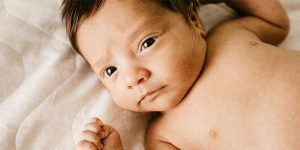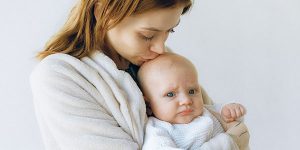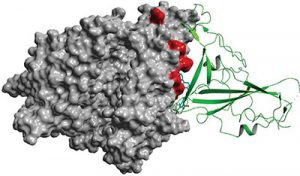1:30min

Photo, courtesy Jonathan Borba, Unsplash
(This stock photo is not a baby from the study)
By Helen Carter
Journalist
Newborn babies of mothers with COVID-19 or whose mothers had coronavirus while pregnant do not have a moderate or high increased risk of ocular abnormalities, a Brazilian study has found.
Researchers said the low rate of ocular abnormalities found in the study was likely within the range of anticipated findings in the absence of COVID-19.
They said their findings, published online in Jama Ophthalmology, ‘likely rule out a moderate or high increased risk of ocular involvement in newborns of mothers with SARS-CoV-2 infection regardless of gestational age’ but more studies were needed to rule out a low increased risk.
The uncontrolled case series of 165 newborns of mothers with COVID-19 infection found a low rate of COVID-19 infection among the babies, and none of six babies (3.6 per cent) who contracted coronavirus from their mothers had ocular abnormalities.
However, 10 other newborns exposed to maternal infection who had negative polymerase chain reaction (PCR) assay results to COVID-19 had ‘fundus abnormalities that may or may not be associated with the congenital disease.’
One presented with retinal vascular tortuosity and venous engorgement seen on ophthalmoscopy after maternal infection occurred at 28 gestational weeks. Seven had intraretinal haemorrhages and two had retinopathy of prematurity (ROP) including one who had an aggressive posterior form and needed treatment with anti–vascular endothelial growth factor injection. One-quarter of the newborns were born prematurely.
Maternal COVID-19 diagnosis varied between first and 40th weeks gestation and although the World Health Organisation reported no evidence of vertical transmission when infection occurs in the third trimester, the study showed a possible different scenario.
Of the six newborns with SARS-CoV-2, one tested positive within 18 days (horizontal transmission,) and five tested positive in the first day of life (possible vertical transmission directly from mother to baby before or after birth.) Infection occurred in the third trimester in four newborns and in the first trimester in one.

Photo, courtesy Anna Shvets, Pexels
(This is a stock photo and not of participants in the study)
‘Given the appearance compatible with postpartum haemorrhages in this study, it is hard to tell whether retinal haemorrhages are secondary to COVID-19 or just incidental findings, since the rate we found (4.2 per cent or seven of 165) is within the published cross-sectional reports (6.7 per cent,)’ researchers wrote.
The two infants born weighing under 1250g with ROP was also in line with expected rates of retinopathy of prematurity in COVID-19–naive populations.
The researchers from the Federal University of Sao Paulo Ophthalmology Department wanted to determine ophthalmological manifestations in newborns after maternal COVID-19 infection. All babies underwent external ocular examination and binocular indirect ophthalmoscopy.
The authors said vertical transmission (passing of pathogen from mother to baby before or after birth) was one of the most serious complications of viral diseases occurring during pregnancy and very often may lead to ocular manifestations, mainly in the retina.
‘Congenital viral infections leading to ocular abnormalities are frequent and devastating,’ they wrote. ‘Because congenital viral infections such as cytomegalovirus and Zika virus can have devastating consequences to the eye of the newborn, it is important to determine if SARS-CoV-2 could also cause ocular manifestations in newborns.’
Additional controlled and larger-sized studies with standardized imaging (fundus images and optical coherence tomography imaging) plus standardization of ophthalmologists would be needed to confirm findings and rule out a low increased risk, they said.
They acknowledged limitations, including lack of standardized imaging and no control group which meant findings could not be generalized but said although more data was needed, vertical transmission of SARS-CoV-2 seemed possible with at least three cases reported elsewhere.
Dry eye drug may be tested against coronavirus
In other coronavirus news, Australian researchers have identified potential drugs for repurposing as SARS-CoV-2 entry inhibitors including sodium lifitegrast (Xiidra), used to treat moderate to severe dry eye.
Griffith University researchers said in mBio that medications used to treat dry eye, cystic fibrosis and a medical dye may guide future strategies for treatment of COVID-19.

Evans blue medical dye (cyan) is shown bound at the interface between the SARS-CoV-2 spike (green) and its host receptor ACE2 (grey.) Image credit: Associate Professor Thomas Haselhorst
Co-led by Professor Michael Jennings and Associate Professor Thomas Haselhorst at the Institute for Glycomics, the researchers used a combination of computer-based and biophysical methods to search for drugs that block the binding of SARS-CoV-2 (the virus causing COVID-19) to cells. These drugs work by interacting with the virus surface protein spike, or its cell receptor ACE2.
‘As well as vaccines, potent drugs to treat COVID-19 are urgently needed,’ said researcher Dr Christopher Day. ‘Due to time and the cost of developing new drugs, our researchers have been pursuing drug repurposing – using drugs that have already been approved for other therapeutic purposes.
‘The identified drugs in this study have potential to provide blueprints for the development of new antiviral compounds for the treatment of COVID-19.’
They identified and tested several drugs in vitro against SARS-CoV-2 infection, using a cell model.
‘Three – Evans blue (medical dye), sodium lifitegrast (dry eye) and lumacaftor (cystic fibrosis) – were found to block virus infection of cells in culture and therefore may be further evaluated for repurposing as therapeutics or to guide the development of new drugs,’ said co-author Dr Benjamin Bailly.
Work is about to start to test the effectiveness of the drugs in advanced, ex vivo human respiratory cell models, facilitated by the Australian-German Fraunhofer International Consortium for Anti-Infective Research initiative.
The Queensland Government and the City of Gold Coast each provided $100,000 for the project.
For all the latest COVID news of relevance to optometrists, members can check out our coronavirus resource page.
Tagged as: COVID-19, International, Patient management